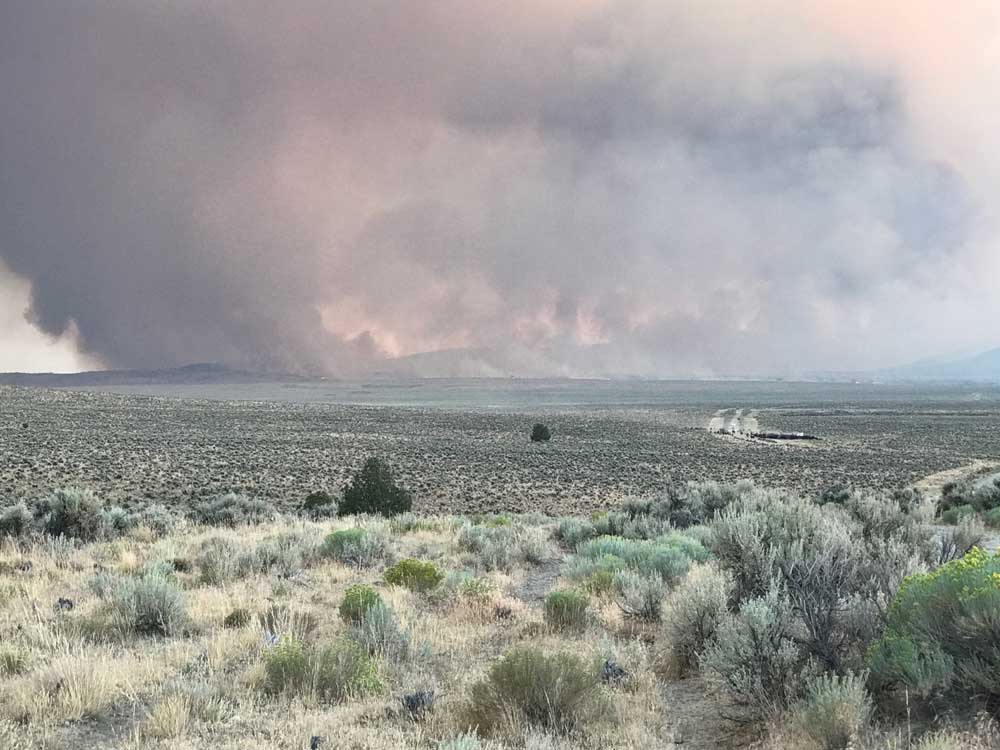Cinder Butte fire up to 56,000 acres
Published 11:27 am Saturday, August 19, 2017

- The Cinder Butte fire burned about 16 miles east of Hampton between Bend and Burns in summer 2017. (Submitted photo)
A wildfire about 60 miles southeast of Bend took off Wednesday and Thursday, growing from an initial report of 10,000 acres to 56,000 acres overnight.
The Cinder Butte Fire started about 1 p.m. Wednesday and is burning on rangeland where the fuel consists of grass, shrubs and juniper rather than large trees.
The fuel source — mixed with hot weather and light wind — allowed the fire to quickly run and by 10 a.m. Thursday it had reached 56,000 acres.
The fire is burning mostly on Bureau of Land Management land, but has moved onto private land.
Firefighters stopped the blaze from growing significantly during the day Thursday, Lisa Clark, spokesperson for the Central Oregon Interagency Dispatch Center, said Thursday night.
She said new crews showed up Thursday afternoon from Washington to give firefighters who worked overnight a rest.
There are now 400 people actively fighting the fire.
“They are running official day shifts and night shifts now, so those guys can get appropriate rest and stay safe,” she said.
In addition to firefighters, Clark said helicopters have dropped water on the fire, as well as four heavy air tankers and four single-engine air takers dropping retardant. Heavy tankers can carry up to 3,000 gallons while single-engine tankers top out at 300 gallons.
Clark said firefighters, with the help of the aircraft, made good headway in keeping the blaze from growing and stopped it from jumping U.S. Highway 395. Firefighters also established a line down the east side of the fire, and they planned to build a line on the west side Thursday night and Friday.
The fire was upgraded in risk Thursday, prompting the additional firefighters and equipment. With that upgrade comes a new fire management team, which will take over Friday morning.
Because it’s a range fire burning in sagebrush country, and not a forest fire, Clark said the attack during the day mostly consists of driving engines along fire lines and spraying water to try to contain it. Cutting fire lines can be more difficult.
“The challenge with range fires is they move so quickly,” she said.
At night, the fire is expected to slow as temperatures drop, giving firefighters a chance to make progress.
Clark said the fire was ruled human-caused as there was no lightning in the area when it started, but the specific cause is under investigation.
The Whitewater Fire, which started July 23 in the Mount Jefferson Wilderness, also grew Thursday and as of about 2:30 p.m. was mapped at 4,579 acres, with 202 firefighters trying to slow it down. The fire is fueled by timber, as well as forest understory and brush. It has closed four trails in the wilderness and is believed to have been caused by lightning. As of Thursday afternoon, it was torching trees and running up hills.
The worst might not be over for the Cinder Butte and Whitewater fires, as well as other current and potential fires throughout the state. With temperatures in the 90s expected to continue through the weekend, the opportunity for fires is ripe. On Wednesday, Gov. Kate Brown issued a state of emergency due to ideal wildfire conditions.
While the Cinder Butte Fire is the closest large wildfire to the Bend area, locals woke up Thursday to signs of fires much further away. Smoke from the Whitewater Fire, as well as several large fires burning in Western Canada have blown into Oregon and by Wednesday evening settled into the Central Oregon area.
However, air quality improved slightly Thursday and was rated as “moderate” by the state Department of Environmental Quality throughout most of Central Oregon. Madras was rated “unhealthy for sensitive groups.” Those west of the Cascades aren’t so lucky as the agency rates the air as “unhealthy” from Eugene to Portland.
Fire danger in Central Oregon remains at “extreme” and campfires on public lands in the area are under various types of restriction. Clark said for most public lands in the area, fires are only being allowed at highly developed campgrounds where there is a fire pit. Before starting a fire, check with the agency that manages the land where you plan to camp for restriction information.
Clark said crews are stretched thin as it is.
“Just be really, really careful when you are out on public lands,” she said.
— Reporter: 541-383-0376, awieber@bendbulletin.com






